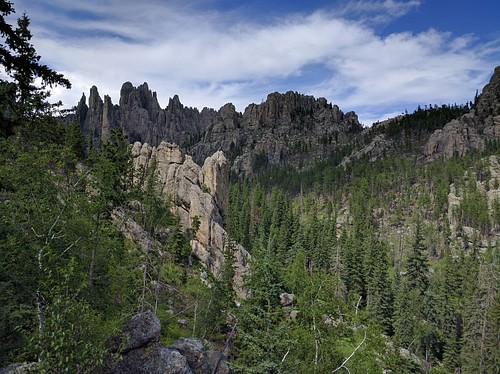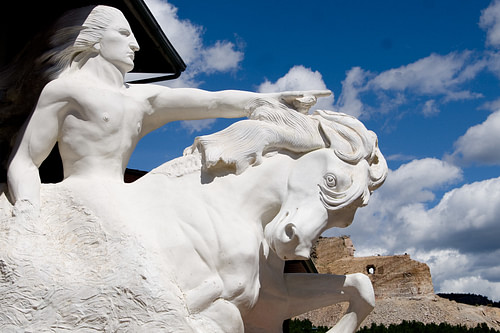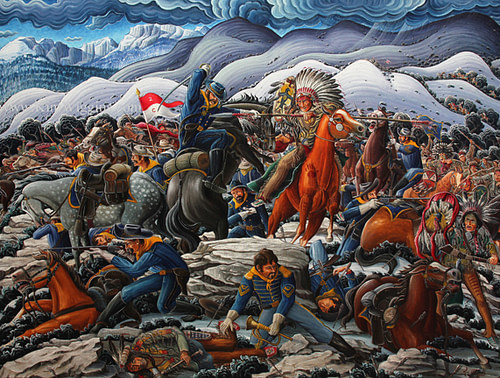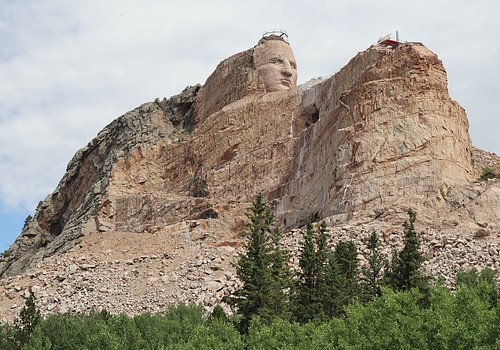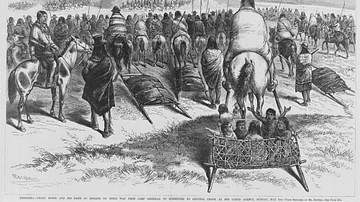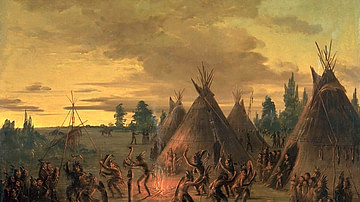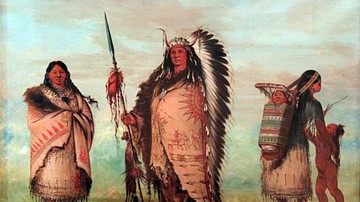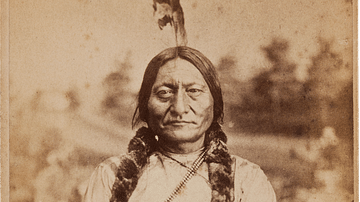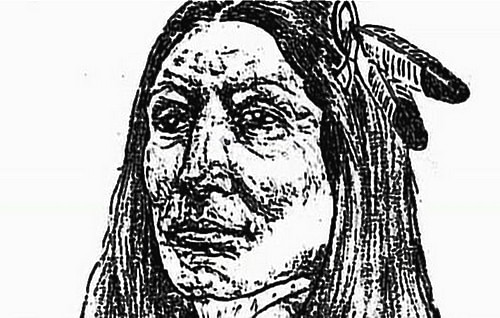
Crazy Horse (Tasunke Witko, l. c. 1840-1877) was an Oglala Lakota Sioux warrior and warband leader considered among the greatest defenders of Sioux lands against the forces of the US government in the 19th century. He is one of the most famous Native American figures in history and among the Sioux's most honored heroes.
Although he is often referred to as a "chief", Crazy Horse was actually a "Shirt Wearer" – a kind of "subchief" – who carried out the decisions of the council and also served as a war chief of a given band of warriors. Even so, Crazy Horse inspired such devotion in his followers that he was regarded as a "chief" and is referenced as such by others, including his second cousin Black Elk (l. 1863-1950) and the Sioux author and physician Charles A. Eastman (also known as Ohiyesa, l. 1858-1939), among others.
His name, Tasunke Witko (Crazy Horse), is accurately translated as "His Crazy Horse" or "His Horse is Crazy" and was his father's and grandfather's name, seemingly referencing a horse that behaved erratically. According to Black Elk, however, the name correlated to Crazy Horse's famous vision in which he saw his horse dancing as though "made only of shadow" in a strange or "crazy" way (53).
Crazy Horse dedicated himself to opposing the US military as early as 1854 following the Grattan Fight (Grattan Massacre) and the subsequent massacre of Little Thunder's camp in 1855 by Colonel William S. Harney. He continued his resistance over the next eleven years and was named a "Shirt Wearer" in 1865. He fought in the Battle of Plate River Bridge (1865), Red Cloud's War (1866-1868), the Battle of the Rosebud (1876), and the Battle of the Little Bighorn (1876). His last full-scale engagement with US forces was the Battle of Wolf Mountain in January 1877.
After bringing his people to the Red Cloud Agency in May 1877 to keep them from starving, Crazy Horse tried to maintain peace with the white people while living near the agency but, perhaps owing to a misunderstanding in translation during a discussion, was arrested and then murdered by a guard at Fort Robinson who stabbed him in the back with a bayonet on 5 September 1877.
Since his death, his reputation as a fearless leader, spiritual role model, and freedom fighter has only continued to grow. The controversial Crazy Horse Memorial in South Dakota, referred to as "the Eighth Wonder of the World in Progress", celebrates his life and the spirit of his people, but long before that memorial was even thought of, Crazy Horse was honored as a great hero.
Youth, Vision & Name
Crazy Horse was born c. 1840 in the Black Hills, South Dakota. His mother, Rattling-Blanket-Woman, named him Chan Ohan (also given as Cha-O-Ha, "Among-the-Trees"), meaning he was one with the natural world, and he grew up being called Curly, owing to his curly hair, or Light Hair, as his hair, and skin, was lighter than other Oglala Lakota Sioux. His father, Crazy Horse, was a medicine man who probably gave him his first bow and arrows as a child and was certainly the first who taught him how to shoot and care for his weapon.
Rattling-Blanket-Woman died when Crazy Horse was around four years old, and he was raised by his aunt and other women he had always known in his life. Scholar Joseph M. Marshall III writes:
Losing one's birth mother was not unknown among the Lakota, but in reality, there were no orphans. Other mothers and grandmothers filled in because they had always been there. (11)
He soon left the care of the women, however, and was taught to hunt, shoot, and defend his people by the males in the family, including his uncle Lone Horn (also known as One Horn, l. 1790-1877), whose maternal uncle was Chief Old Smoke (l. 1774-1864), brother of Walks-as-She-Thinks, the mother of Red Cloud (l. 1822-1909). Crazy Horse had a younger half-brother, Little Hawk (l. c. 1842-1871), and grew up playing with him and with Lone Horn's four sons: Spotted Elk, Frog, Roman Nose (not the same as the Cheyenne warrior Roman Nose, also known as Hook Nose), and Touch-the-Clouds. At some point in his younger years, he was taken under the care of the warrior High Backbone (also known as Hump, l. c. 1820-1870), who became his mentor.
In keeping with the seven sacred rites of the Lakota Sioux, Crazy Horse was purified and made his vision quest (though, according to some sources, he neglected the purification ritual) and received the vision which, according to Black Elk, would define his life. Marshall describes the vision:
The dream began at a lake, a small still lake. Bursting upward from the blue calmness, a horse and its rider broke through the surface and rode out across the land. The rider was a man, a slender man who wore his hair loose. A stone was tied behind his left ear, a reddish-brown stone. A lightning mark was painted across one side of his face. On his bare chest were blue hailstones. Behind them to the west as they galloped was a dark, rolling cloud rising higher and higher. From it came the deep rumble of thunder and flashes of lightning. The horse was strong and swift, and it changed colors: red, yellow, black, white, and blue. Bullets and arrows suddenly filled the air, flying at the horse and rider, but they all passed without touching them. Close above them flew a red-tailed hawk, sending out its shrill cry. People, his own kind, suddenly rose up all around and grabbed the rider, pulling him down from behind. And the dream ended. (71-72)
Crazy Horse is said to have related the vision to his father and, perhaps, to Hump who then told it to others. Among those who heard the story was Crazy Horse's second cousin, Black Elk, who describes the vision:
Crazy Horse dreamed and went into the world where there is nothing but the spirits of all things. That is the real world that is behind this one, and everything we see here is something like a shadow from that world. He was on his horse in that world, and the horse and himself on it and the trees and the grass and the stones and everything were made of spirit, and nothing was hard, and everything seemed to float. His horse was standing still there, and yet it danced around like a horse made only of shadow, and that is how he got his name, which does not mean that his horse was crazy or wild, but that in his vision it danced around in that queer way. It was this vision that gave him his great power, for when he went into a fight, he had only to think of that world to be in it again, so that he could go through anything and not be hurt. (53)
Whether the vision had anything to do with Crazy Horse's name, it is established that his father and grandfather had the same name. Details differ on when and why the father gave his name to his son – according to some accounts it was after his first kill, others say it was after he rescued a Lakota woman following Colonel Harney's massacre of Little Thunder's camp – but, either way, c. 1855, the elder Crazy Horse passed his name to his son and took the name Waglula ("Worm"), and his son then made the name famous.
Grattan Fight & Shirt Wearer
In August 1854, a cow, which had wandered off from a Mormon wagon train, walked into the camp of Chief Conquering Bear (l. c. 1800-1854). As the food supplies promised by the US government had not arrived, the people were hungry, and the cow was killed and eaten. The Mormon party reported the cow stolen by the Sioux, and Lieutenant Hugh Fleming of Fort Laramie contacted Conquering Bear demanding the surrender of the person who had taken the cow.
Conquering Bear offered compensation, but it was refused. On 19 August 1854, 2nd Lieutenant John L. Grattan led a command of 30 soldiers to the Sioux camp to arrest the man they claimed had stolen the cow. Conquering Bear refused to surrender him, the situation escalated, and Conquering Bear was shot and mortally wounded. The Sioux returned fire, killing all 31 soldiers.
Crazy Horse witnessed this event (the Grattan Fight or Grattan Massacre) and later, once the US Army retaliated under the command of Colonel Harney, found the massacred bodies of Little Thunder's camp where he rescued a woman, the only survivor (an engagement known as the battle of Ash Hollow or the Harney Massacre, September 1855). His war with the invading white man is understood to have begun at the Grattan Fight, which also began the First Sioux War of 1854-1856. Whenever he went into battle, he painted himself with the lightning bolt on his cheek and hailstones on his chest as in his vision.
Between 1854-1865, Crazy Horse led war parties against neighboring tribes and harassed white travelers, trading posts, and outposts. The Sand Creek Massacre of 29 November 1864 tightened the alliance between the Lakota Sioux and the Cheyenne and Arapaho, and, in July 1865, Crazy Horse was one of the leaders of a war party at the Battle of Platte River Bridge, along with Roman Nose (also known as Hook Nose, l. c. 1830-1868) and others including Red Cloud and Morning Star (also known as Dull Knife, l. c. 1810-1883). His courage and tactical genius were recognized afterwards when he was honored with the title of Shirt Wearer.
Red Cloud's War
The Fort Laramie Treaty of 1851 acknowledged the claims of the Native American nations to ancestral lands, which were to be regarded as "Indian Territory" that the United States had no claim on. In 1863, however, gold was discovered in Montana, and the Bozeman Trail was opened, bringing a stream of miners and settlers to the region. When the US government then sent Colonel Henry B. Carrington (l. 1824-1912) to build forts throughout the region to protect these people, Red Cloud declared war.
Red Cloud orchestrated the far-ranging attacks on the civilian details gathering hay and wood for the forts, which brought soldiers out to defend them, but he left the details of how these engagements were fought to his commanders, including Crazy Horse. From July onwards in 1866, Crazy Horse and the other war chiefs continually struck at the civilian details, travelers, and outposts, running off horses and cattle and inflicting casualties as they could.
On 21 December 1866, Crazy Horse attacked a detail of woodcutters and brought a command under Captain William J. Fetterman (l. c. 1833-1866) out of Fort Phil Kearny in response. Crazy Horse and his decoys lured Fetterman over the Lodge Ridge Trail into a valley where 1500-3000 warriors ambushed them, killing all 81 soldiers in what later became known as the Battle of the Hundred-in-the-Hands or the Fetterman Massacre.
Between 1867 and 1868, Crazy Horse continued to lead war parties against the invaders and participated in both the Hayfield Fight (1 August 1867) and the Wagon Box Fight (2 August 1867). When Red Cloud finally concluded a peace with the US Army through the Fort Laramie Treaty of 1868, Crazy Horse disagreed with his decision (as did Sioux War Chief Gall and Sitting Bull, among others) and refused to attend the meeting or sign the document.
Black Buffalo Woman & Loss of the Shirt
In 1870, Crazy Horse lost his brother, Little Hawk in battle. According to some accounts, this was in a raid on the Snake nation, while according to others, it was against the US Army. Accounts of Crazy Horse's life often differ significantly and feature the same details for different events. Charles A. Eastman tells a story about Crazy Horse rescuing Hump from a Gros Ventres war party which has the same details that Black Elk gives regarding Crazy Horse saving Little Hawk from a Crow war party.
This same year, Crazy Horse took a woman, Black Buffalo Woman, who was married to the warrior No Water, away from the village while No Water was absent. Sources differ on this event, as they do with many others, but Black Buffalo Woman is sometimes referenced as the great love of Crazy Horse's life who only married No Water because Crazy Horse was away fighting the First Sioux War.
No Water, who had a reputation as a jealous man, tracked them down to a teepee and entered with a pistol. He fired at Crazy Horse, but another man, often given as his cousin Touch-the-Clouds, knocked his arm so the bullet only hit the edge of Crazy Horse's nose and down the left side of his jaw. Black Buffalo Woman was sent back to No Water, and a council was called to decide what to do about Crazy Horse's transgression in trying to steal another man's wife.
The council decided to strip him of the title of Shirt Wearer, and, according to Marshall, rumors circulated that his shirt was to be given to Red Cloud, who was related to No Water just as he was to Crazy Horse. Eventually, they decided giving the shirt to anyone would only cause more problems, and "so they solved the problem by letting it lie, never to pick it up again. Never again would the Oglala have new Shirt Wearers" (Marshall, 162). The elders arranged for Crazy Horse to marry Black Shawl, one of the women who had taken care of him after he was wounded. Red Cloud then sent another woman, Nellie Larrabee, to live with Crazy Horse, ostensibly as a second wife but, according to some sources, to spy on him.
Great Sioux War
In 1874, gold was discovered in the Black Hills – a site sacred to the Sioux as their point of origin and promised to them, "as long as the grass shall grow and the rivers flow" by the Fort Laramie Treaty of 1868 – and settlers began arriving in large numbers. This treaty, like all the others, was broken by the US government as soon as it suited their purposes, and the Black Hills Gold Rush of 1876 began, igniting the Great Sioux War of 1876-1877.
Crazy Horse, though no longer a Shirt Wearer, was still a powerful war leader with a devoted following and led a band against General George R. Crook (l. 1828-1890), defeating him at the Battle of the Rosebud on 17 June 1876. He was central to the victory at the Battle of the Little Bighorn (25-26 June 1876), defeating and killing Lt. Colonel George Armstrong Custer, but, although many eyewitness accounts attest to his courage in battle, no one seems to know precisely what he did. The movements and actions of the US troops and commanders are well documented, but those of Crazy Horse and his warriors are far less so.
The US Army retaliated swiftly, scattering the Cheyenne, Arapaho, Sioux, and their allies. Sitting Bull (l. c. 1837-1890), the great Sioux medicine man who had foreseen the victory at the Little Bighorn, fled to Canada while Crazy Horse led his people away from the forces of the white man. Crazy Horse engaged the US Army at the Battle of Wolf Mountain on 8 January 1877, and, although technically a draw, this was a victory for the United States in that Crazy Horse had not decisively won and the morale of his warriors fell.
Although Crazy Horse was not defeated at Wolf Mountain, he withdrew from the field and never fought again. The US government, having slaughtered the buffalo en masse, the major food source for the Plains Indians, had reduced them to relying on supplies provided by US civilian contractors. These supplies – when they were actually sent – were only available on the reservations the US government had established, and Crazy Horse refused to submit to reservation life. He wandered with his people, usually starving throughout the first months of 1877, and was honored through a Sun Dance dedicated to him, but, on 5 May 1877, he arrived with his band at Fort Robinson, Nebraska, to negotiate terms of surrender.
Conclusion
Crazy Horse and his band set up their camp near the Red Cloud Agency (later the Pine Ridge Reservation) and lived there in relative peace until August 1877 when word arrived that Chief Joseph (l. 1840-1904) and his Nez Perce had left their reservation and were fleeing toward Canada. Crazy Horse was asked to help subdue the Nez Perce and return them to their reservation, and, allegedly, he replied that he would fight with the US forces until all the Nez Perce were killed, but – again, allegedly – this was mistranslated by the interpreter as "I will fight until not a single white man is left."
Orders were issued for his arrest, and, on 5 September 1877, while resisting the guards at Fort Robinson, Crazy Horse was stabbed in the back by a guard with a bayonet. The wound was fatal, and he died that night. His parents and relatives took his body and interred it at an undisclosed location. No one to this day, except members of his family, know where he is buried. Charles A. Eastman writes:
Thus died one of the ablest and truest American Indians. His life was ideal; his record clean. He was never involved in any of the numerous massacres on the trail, but was a leader in practically every open fight…as worthy of honor as any who ever breathed God's air in the wide spaces of a new world. (88)
In 1848, construction of the Crazy Horse Memorial began in South Dakota, at first entirely by Polish-American sculptor Korczak Ziolkowski (l. 1908-1982), at the request of Lakota Chief Henry Standing Bear (l. c. 1874-1953). The project is still underway, carried on by the Ziolkowski family, who, from the start, have refused any funding from the US government.
Like Red Cloud and Sitting Bull, the US post office issued a stamp honoring Crazy Horse in 1982, but the United States government still has not addressed the issues any of these men fought for. Even so, the name of Crazy Horse continues to inspire those who continue his fight in the present day.
